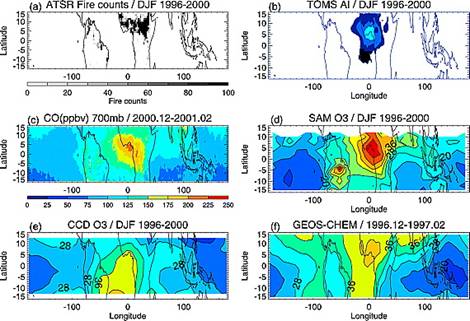SAM Tropospheric
Ozone
Kim
J. H., S. Na, M. J. Newchurch, R. V. Martin (2005), Tropical tropospheric
ozone morphology and seasonality seen in satellite and in situ
measurements and model calculations, J. Geophys. Res., 110, D02303,
doi:10.1029/2003JD004332. Full
Text
Using the scan angle method the Northern
Atlantic paradox is analyzed for its validity. The scan angle method
along with the GEOS-CHEM chemical transport model illustrates the seasonality
seen with in situ ozone measurements. However, this seasonality
is not shown using the residual based method of tropospheric ozone retrieval. Based
upon this information it is concluded that the Northern Atlantic paradox
does not actually exist.

Figure 4. Distribution of (a)
fire counts from ATSR averaged for 1996–2000, (b) aerosol index
from TOMS averaged for 1996–2000, (c) CO from MOPITT for 2000,
(d) tropospheric ozone column (DU) from SAM averaged for 1996–2000,
(e) tropospheric ozone column (DU) from CCD averaged for 1996–2000,
and (f) tropospheric ozone column (DU) from GEOS-CHEM model for 1997
in the December-January-February time period.
The above figure illustrates that during
the months of December, January, and February the residual based method
of tropospheric ozone retrieval does not agree with the location of the
ozone precursors as monitored by MOPITT. Use of the scan angle
method shows better agreement with the location of CO from MOPITT as
well as the modeled tropospheric column ozone from GEOS-CHEM.
|